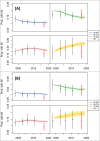Forecast of myocardial infarction incidence, events and prevalence in England to 2035 using a microsimulation model with endogenous disease outcomes
- PMID: 35771859
- PMCID: PMC9246106
- DOI: 10.1371/journal.pone.0270189
Forecast of myocardial infarction incidence, events and prevalence in England to 2035 using a microsimulation model with endogenous disease outcomes
Abstract
Background: Models that forecast non-communicable disease rates are poorly designed to predict future changes in trend because they are based on exogenous measures of disease rates. We introduce microPRIME, which forecasts myocardial infarction (MI) incidence, events and prevalence in England to 2035. microPRIME can forecast changes in trend as all MI rates emerge from competing trends in risk factors and treatment.
Materials and methods: microPRIME is a microsimulation of MI events within a sample of 114,000 agents representative of England. We simulate 37 annual time points from 1998 to 2035, where agents can have an MI event, die from an MI, or die from an unrelated cause. The probability of each event is a function of age, sex, BMI, blood pressure, cholesterol, smoking, diabetes and previous MI. This function does not change over time. Instead population-level changes in MI rates are due to competing trends in risk factors and treatment. Uncertainty estimates are based on 450 model runs that use parameters calibrated against external measures of MI rates between 1999 and 2011.
Findings: Forecasted MI incidence rates fall for men and women of different age groups before plateauing in the mid 2020s. Age-standardised event rates show a similar pattern, with a non-significant upturn by 2035, larger for men than women. Prevalence in men decreases for the oldest age groups, with peaks of prevalence rates in 2019 for 85 and older at 25.8% (23.3-28.3). For women, prevalence rates are more stable. Prevalence in over 85s is estimated as 14.5% (12.6-16.5) in 2019, and then plateaus thereafter.
Conclusion: We may see an increase in event rates from MI in England for men before 2035 but increases for women are unlikely. Prevalence rates may fall in older men, and are likely to remain stable in women over the next decade and a half.
Conflict of interest statement
The authors have declared that no competing interests exist.
Figures




Similar articles
-
Long-term trends in population-based hospitalisation rates for myocardial infarction in England: a national database study of 3.5 million admissions, 1968-2016.J Epidemiol Community Health. 2022 Jan;76(1):45-52. doi: 10.1136/jech-2021-216689. Epub 2021 Jul 12. J Epidemiol Community Health. 2022. PMID: 34253559 Free PMC article.
-
Hypertension and burden of myocardial infarction in China: risk factors, gender differences and temporal trends from a National Chronic Disease Surveillance study (2021-2023).Blood Press. 2025 Dec;34(1):2487584. doi: 10.1080/08037051.2025.2487584. Epub 2025 Apr 10. Blood Press. 2025. PMID: 40188379
-
Relative contribution of trends in myocardial infarction event rates and case fatality to declines in mortality: an international comparative study of 1·95 million events in 80·4 million people in four countries.Lancet Public Health. 2022 Mar;7(3):e229-e239. doi: 10.1016/S2468-2667(22)00006-8. Lancet Public Health. 2022. PMID: 35247353
-
Assessing the external validity of model-based estimates of the incidence of heart attack in England: a modelling study.BMC Public Health. 2016 Nov 3;16(1):1135. doi: 10.1186/s12889-016-3782-6. BMC Public Health. 2016. PMID: 27809823 Free PMC article.
-
Lifelong Gender Gap in Risk of Incident Myocardial Infarction: The Tromsø Study.JAMA Intern Med. 2016 Nov 1;176(11):1673-1679. doi: 10.1001/jamainternmed.2016.5451. JAMA Intern Med. 2016. PMID: 27617629
References
-
- British Heart Foundation. Heart and Circulatory Disease Statistics 2021. London: British Heart Foundation; 2021. Available from: https://www.bhf.org.uk/what-we-do/our-research/heart-statistics/heart-st...
-
- Scarborough P, Wickramasinghe K, Bhatnagar P, Rayner M. Trends in coronary heart disease 1961–2011. London: British Heart Foundation; 2011.
-
- Determinants of the decline in mortality from acute myocardial infarction in England between 2002 and 2010: linked national database study. BMJ, 2013;347: f7379 doi: 10.1136/bmj.f7379 [correction to Smolina K, Wright FL, Rayner M, Goldacre MJ. Determinants of the decline in mortality from acute myocardial infarction in England between 2002 and 2010: linked national database study. BMJ. 2012;344: d8059.] - DOI - PMC - PubMed
Publication types
MeSH terms
Grants and funding
LinkOut - more resources
Full Text Sources
Medical

